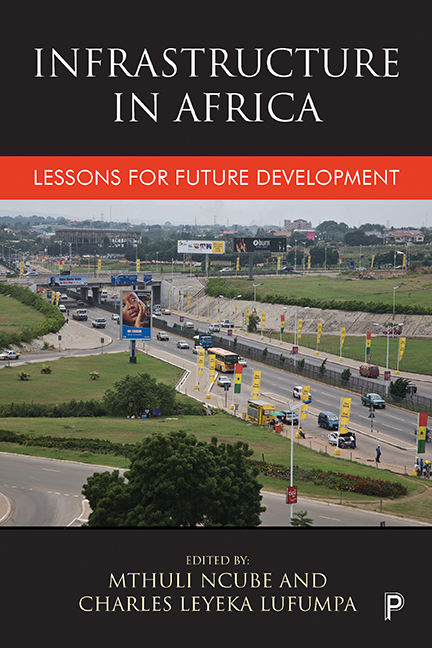Book contents
- Frontmatter
- Contents
- List of figures
- List of tables
- List of boxes
- Notes on contributors
- Acknowledgements
- Foreword
- Introduction: Infrastructure in African development
- Part 1 Spatial and demographic contexts
- Part 2 Sector-specific issues
- Part 3 Regional issues
- Part 4 Financing issues
- Part 5 Concluding remarks
- Index
five - Water and sanitation in Africa: current status, trends, challenges and opportunities
Published online by Cambridge University Press: 05 April 2022
- Frontmatter
- Contents
- List of figures
- List of tables
- List of boxes
- Notes on contributors
- Acknowledgements
- Foreword
- Introduction: Infrastructure in African development
- Part 1 Spatial and demographic contexts
- Part 2 Sector-specific issues
- Part 3 Regional issues
- Part 4 Financing issues
- Part 5 Concluding remarks
- Index
Summary
Introduction
The 21st century will prove to be of great importance to African countries, as they are confronted with the challenge of coping with an accelerated urbanization process, while simultaneously striving to take advantage of the opportunity to become one of the world's largest agricultural producers. The ability of countries to achieve certain aims requires, among other things, that they respond to the increase in demand for infrastructure endowments generated by economic growth and changes in the production structure. Demands for roads, rail, ports and airports, for electricity and information and communications technology, and especially for water and sanitation, will increase vis-à-vis productive and social needs. In this context, it is important for African countries to identify what they hope to achieve over the next 50 years, what types of investment will help them accomplish related goals, and how much this will cost them.
This chapter focuses on access to water and sanitation services in Africa. Improvements in water and sanitation are known to have huge positive effects on health and well-being. Cutler and Miller (2005) found that public investments in 13 major US cities at the beginning of the 20th century had a powerful positive effect on health, cutting total mortality by half, and infant mortality by three-quarters. Leipzinger et al (2003) also found that, apart from traditional variables (for example, income, assets, education and direct health interventions), better access to basic infrastructure services played an important role in improving child health outcomes.
The first part of the chapter outlines the urbanization and access rates trends. It then discusses the main factors underlying anticipated trends in investment needs over the next 50 years. The third part estimates the cost of these requirements. The fourth part discusses the challenges confronting the continent in terms of its ability to cope with the growing demand for water and sanitation services. Clearly articulating and documenting all these issues enables policymakers and investors to make sound decisions regarding water and sanitation investments on the continent.
Urbanization and access to water and sanitation services
Urbanization
Urbanization is still incipient in most African countries, but will be consolidated in the coming decades. The median urbanization rate by region is shown in Figure 5.1. Urbanization has reached a high rate in only few countries. For all regions considered, less than 70% of the population lives in urban areas.
- Type
- Chapter
- Information
- Infrastructure in AfricaLessons for Future Development, pp. 155 - 184Publisher: Bristol University PressPrint publication year: 2017
- 1
- Cited by



